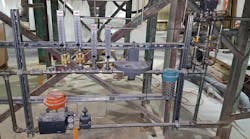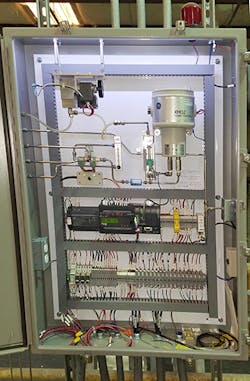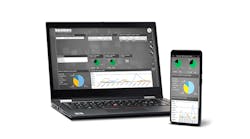Gulf States Instruments expands business with automation solutions
Our core business at Gulf States Instruments (GSI) began more than 20 years ago with technicians applying their experience and proficiency with high-end calibration equipment to help processing customers optimize operations. Throughout subsequent years, we carefully built out our maintenance and testing contract business and grew our clientele. A unique part of our success has developed as the team actively looked for additional ways to help their clients.
In one case, GSI technicians had worked at a toll manufacturing client for many years, calibrating instruments and analyzers. They noticed that part of the process was manual, consuming worker time and creating the possibility for errors and waste. The techs were able to suggest some ways to improve the situation by providing basic electrical interlocks, and they implemented a solution.
It was the successful start of an expanded scope of services that now includes delivery of more comprehensive automation projects. Even though this type of control system integration was not originally a part of the company business, our personnel gained a deep understanding of the instruments, equipment and processes involved. Combining this knowledge with, in this case, automation products and support from key partner AutomationDirect enabled us to develop a series of systems that improve safety and production for our clients, while saving them time and money.
Getting the right mix
Toll manufacturers and processors provide production services to other manufacturers on a contract basis, often blending, mixing or compounding chemicals or dry materials, and then transporting the products to the next company in the manufacturing chain.
Due to the nature of the materials involved, combustible vapors or dust can be created during processing. A common way to protect against ignition in these cases is by blanketing the vessel’s headspace with an inert gas, usually nitrogen, displacing oxygen that would otherwise support ignition.
A source of bulk nitrogen is needed, as well as control valves, piping and pressure instrumentation to manage the flow and maintain sufficient pressure. Other analytical instruments and tubing are needed to continuously sample the headspace gas and ensure it's safe and inert.
Among GSI’s toll manufacturing customer base, inerting procedures often called for an employee to manually adjust the nitrogen valves and monitor vessel status. This was a time-consuming task, both to initially inert the vessel, and then to maintain the proper atmosphere during a batch. It was all too easy to over-pressurize a vessel, wasting nitrogen at the very least. There was also the opportunity for error where an operator would not establish or maintain a proper nitrogen level in the headspace, creating an unsafe situation.
A better way
As GSI technicians worked to calibrate instrumentation and maintain associated devices, they could see the inerting problems firsthand. Using their experience, they were first able to implement some basic hardwired interlocks to help improve the situation for operators.
Figure 2: The control panel houses the PLC and associated components, along with the headspace gas sampling tubing and analyzer.
Results were so positive that even more upgrades were considered. GSI personnel were familiar with various types of facilities, and especially with the design and operation of many types of custom-built, packaged systems. With this background, they realized that a programmable logic controller (PLC) together with a local human-machine interface (HMI) could help monitor the inerting system instrumentation, control the associated valving, and provide a way for operators to better visualize and adjust system operation (Figure 1).
Before jumping into detailed hardware design and software programming, technicians worked with the toll manufacturer to ensure the automation task was clearly defined. This effort included documenting a sequence of operations and detailing specifications, so elements like valves and analyzers could be sized appropriately.
With initial design elements in hand, the focus turned to the selection of an automation platform. The team already had good knowledge of the analytical instruments and electrically actuated devices to be used. Furthermore, due to the nature of calibration work, they'd interacted with PLCs and HMIs from various vendors. Based on past positive experiences with the company and its products—from the standpoint of technical support, customer service, product reliability and value—the team settled on AutomationDirect as their partner.
From past experience, the team knew an initial automation design often begins easily enough. The challenge would be in translating general system capabilities and basic automation functions into specific hardware and software compatible with the process conditions and electrical connectivity. The availability of comprehensive, user-friendly application guidelines on the AutomationDirect website streamlined specification of the correct parts, and provided a one-stop-shop for procuring associated control panel components (Figure 2).
Figure 3: The system's human-machine interface enables operators to visualize and manage the interting system status, with the most critical information displayed in a large, clear format for easy viewing from a distance.
The right look and feel
While the underlying functionality must be correct, it's also important that the operator interface delivers the right data along with ease of use. In this case, the end user had some minimum requirements for information to be communicated, as well as providing the right look and feel. Key requirements were:
- Clear indication of the most important values;
- Easy access to critical control functions;
- Intuitive presentation for batching operations; and,
- Navigation and means for calibrating, maintaining and testing system elements.
Further discussions helped the team storyboard a suitable HMI configuration. Multiple screens would be needed to provide the information. The batching process includes two primary operating modes—blending and clean-out—each of which needed its own screen. A third screen would be needed to provide more detailed and less frequently used information for maintenance personnel.
Because the HMI display is remotely located away from the blender, it was important that the most critical information be viewable from a distance. In particular, a large visual indicator shows the current oxygen level (Figure 3). If any operating parameter or function exceeds limits, the warning condition is also displayed in large text. For these cases, an audible alert calls the operators’ attention to the HMI, so they can understand the issue and take appropriate action. The final design is not only easy to use for operators and maintenance personnel, it also ensures the system can be operated in the safest way possible.
Flexibility for the future
After completing the first inerting system, the client was so impressed that they decided to continue their automation efforts. As of this time, four more automated inerting systems have been implemented and placed into service, each with design improvements based on experience with past implementations. Some enhancements include improved documentation and loop tuning. Other advances represent new capabilities such as reporting and testing to support process safety management (PSM).
Presently, the inerting systems are localized and standalone. However, the team is also evaluating the possible addition of remote and mobile connectivity for support and data gathering purposes.
When GSI first identified their customer’s need for improved safety and reduced operational costs for inerting systems, it was clear that automation was the answer. By applying their deep process and industry experience, and carefully choosing the right automation products, the GSI team was able to deliver a solution to help their customer.
With several inerting automation projects successfully completed and in operation, the end user appreciates how the system accurately performs the inerting task, reducing expensive nitrogen waste and freeing personnel to be more efficient. Safety is increased because the possibility of human error is greatly reduced. New features are also possible, such as how the automation system periodically performs a self-checking step, assuring it's operating within specifications or proactively warning users otherwise. Other new features can be easily implemented due to the automation system’s inherent flexibility.
About the author:
Robert Boudreaux has been in the industrial instrumentation industry for 45 years along the U.S. Gulf Coast and is owner of Gulf States Instruments in Mobile, Ala., an industrial instrument testing company providing onsite testing, documentation and maintenance services to industrial and utility customers. The company’s core business is assisting customers with maintaining compliance by providing services for testing and documenting the accuracy of all process critical control loops, safety systems, and environmental measurements required by federal and state agencies. The company also provides other services that relate to maintenance and process improvement efficiencies. He can be contacted at Gulf States Instruments at [email protected].

Leaders relevant to this article:





